A Private Tour today. We had planned a combination of a farmland walk for raptors in the morning and then down to the coast for the afternoon. It was a lovely sunny day, but with a gusty wind which kept the temperature down to a pleasant 20C.
To start the day, we drove inland and stopped by a footpath, which we made our way down. There were not so many butterflies out this morning, with the wind keeping most of them down, but in the shelter of the trees and hedges we found a few Gatekeepers, a selection of whites (Large White, Small White and Green-veined White) and a single Speckled Wood. We stopped to admire the intricate papery wall of a wasp nest. It appeared to have been excavated overnight, presumably by a badger, but thankfully the wasps were still rather sluggish this morning.
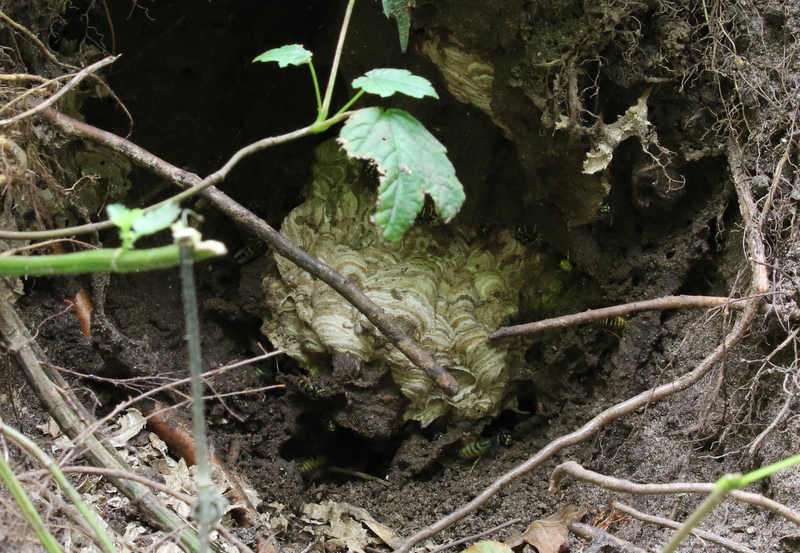 Wasp nest – presumably excavated by a badger overnight
Wasp nest – presumably excavated by a badger overnight
A sunny clearing sheltered by trees and full of brambles and wildflowers looked promising for butterflies, but it was perhaps a bit early still. A couple of Goldcrests flitted around at the back and a Green Woodpecker called. We could hear the plaintive call of a Bullfinch too from deep in cover. As we walked out into the open farmland again, a Great Spotted Woodpecker flew across the field in front of us. A Yellowhammer was singing from a nearby hedgerow.
It was perhaps a bit windy for raptors too today, certainly for any number of them to be soaring up into the sky. We spent a while scanning the fields – amongst the things we did manage to see, a Kestrel hovered over the field in front of us, battling to hold itself in place in the wind. We could hear Common Buzzards mewing from the trees, but they were obviously reluctant to venture out above the trees.
As we made our way back to the car, we stopped to admire a group of Swallows coming and going from the wires above the path. They were mostly juveniles, short-tailed and with light brown-orange faces, but a couple of longer-tailed adults flew in and joined them. At one point, there were fifteen Swallows gathered on the wires altogether – reminding us that the breeding season is coming to and end and it is not long now before our summer visitors will start to leave us.
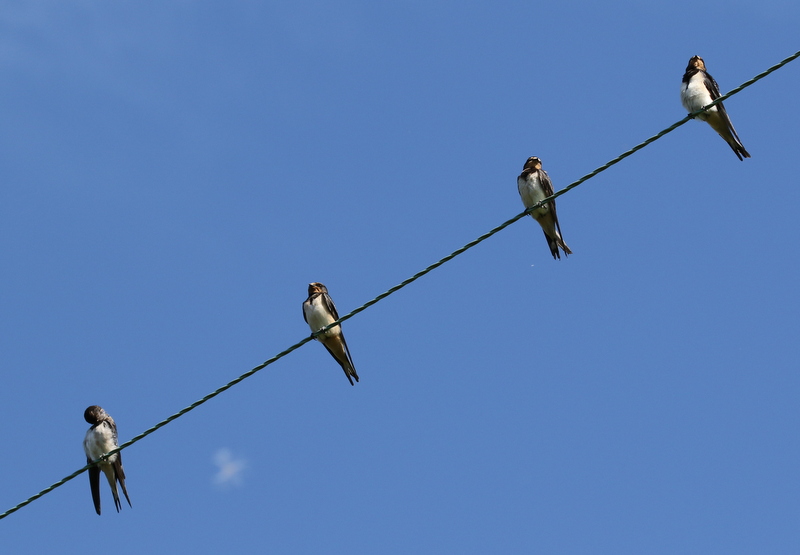 Swallows – juveniles gathered on the wires
Swallows – juveniles gathered on the wires
Titchwell was our next destination. We decided to have a quick walk out to Patsy’s Reedbed and beyond before lunch. It was nice and sheltered in the trees. We could hear a Greenfinch wheezing overhead and when we got to the feeders in front of the visitor centre, we could see a couple there and a few Chaffinches and Goldfinches too. A variety of Long-tailed Tits, Great Tits and Blue Tits were all feeding out of the wind in the sallows.
We stopped to look at Patsy’s Reedbed for a while. All the ducks are in eclipse plumage now, so various shades of brown, although some of them looking quite richly coloured in the sunshine – a mixed selection of Gadwall, Mallard and Teal. The family of Common Pochard are fully grown now, but still diving in front of the screen. There are still several juvenile Avocets on here, at various stages of development, with their noisy parents still chasing off anything that gets too close. A single Ruff was on one of the islands, in and out of the mob of Canada Geese. A Common Tern hovered over the water in front of us.
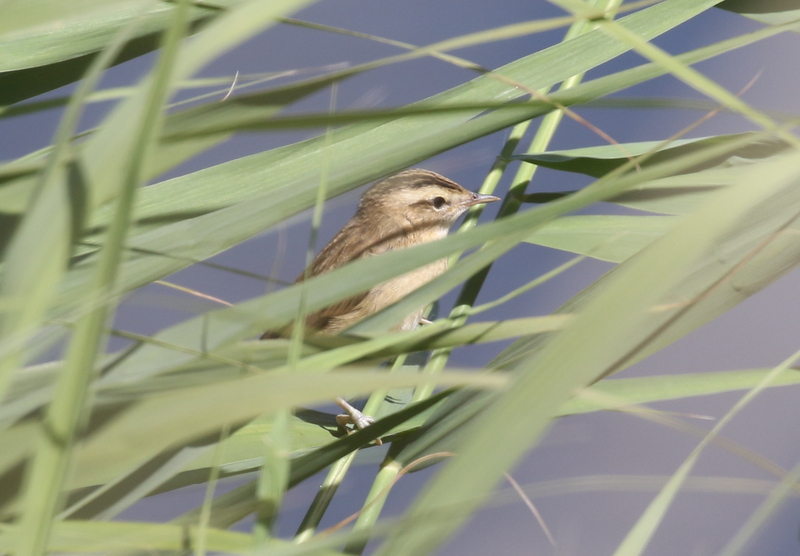 Sedge Warbler – a pair were feeding in front of the screen
Sedge Warbler – a pair were feeding in front of the screen
There was a lot of activity around the reeds in front of the hide. A Reed Warbler flew from the tall grass by the screen down to the water’s edge, where a fully grown youngster appeared to be fed. Then a couple of small birds appeared in the short grass just in front of us and a closer look revealed a pair of Sedge Warblers, a great view of them out in the open. We could hear the young calling from the reeds nearby, and they kept flying back an forth to feed them. Then over the back of the water, a couple of Bearded Tits appeared at the back of the pool, low down in the reeds. We got a great look at them through the scope, a couple of tawny brown juveniles. A Yellow Wagtail landed briefly with the Pied Wagtails, before flying past us calling.
Over beyond the main reedbed, something spooked all the birds on the freshmarsh and we looked across to see a group of large white shapes circling, Spoonbills. A few seemed to drop back towards the freshmarsh, but most appeared to drop over the bank towards Brancaster. The Autumn Trail is open now (from 1st August to 31st October), so we made our way round there to see how many we could still find. With a bit of careful positioning, we could count fifteen Spoonbills out on the saltmarsh, doing what they like to do best and sleeping!
 Spoonbills – fifteen mostly asleep on the saltmarsh from Autumn Trail
Spoonbills – fifteen mostly asleep on the saltmarsh from Autumn Trail
From round at the viewpoint at the end of the Autumn Trail, we could only see a single distant Spoonbill still on the freshmarsh. However, we did manage to pick up a few waders here. Eight Spotted Redshanks were tucked in down by the fence. Seven were in silvery grey and white winter plumage already but one was still stunning in pretty much full, jet-black summer plumage. On the mud in front of us, a Common Sandpiper was not much bigger than the Pied Wagtail beside it.
 Common Sandpiper – feeding on the mud at the end of the Autumn Trail
Common Sandpiper – feeding on the mud at the end of the Autumn Trail
The East Trail is often good for dragonflies, and there were plenty of Common Darters trying to bask along the path despite the wind. We had watched an Emperor Dragonfly hawking around the edge of Patsy’s Reedbed, but we had a better view of a female which was ovipositing on a small, recently cleared reedbed pool by the boardwalk on the way back.
 Emperor Dragonfly – ovipositing on a reedbed pool
Emperor Dragonfly – ovipositing on a reedbed pool
After lunch, we made our way back out onto the reserve along the main path. There were quite a few ducks on the reedbed pool as usual, with Shoveler an addition to the day’s list. Over towards the back, we could see an adult Great Crested Grebe with its now almost fully grown but still stripy-faced juvenile. A Little Grebe was lurking by the reeds too. A couple of Curlew flew round over the saltmarsh behind us, calling.
We stopped off in Island Hide to have a good look at the freshmarsh. Most of the adult Shelduck have departed, gone over to the Continent to moult. The juveniles are left behind, so most of the Shelduck left here are youngsters at this time of year.
 Shelduck – the juveniles are left behind when the adults leave to moult
Shelduck – the juveniles are left behind when the adults leave to moult
There are lots of Black-tailed Godwits and Avocets on the freshmarsh at the moment, the two commonest waders here now. A tight-packed line of godwits out in the middle were Bar-tailed Godwits, presumably roosting here away from the wind whistling over the beach.
There are not so many small waders on here at the moment. We found a scattering of Dunlin around the muddy margins of the islands, mostly streaky-bellied juveniles but with the odd black-bellied adult still. In with a couple of them, we found a single Little Stint, much smaller than the Dunlin next to it, with white underparts and short bill.
From back up on the main footpath, we got a closer look at the Ruff. Most of the males are already in winter plumage, grey-brown above and very pale below, but a couple of the smaller females (Reeves) were still mostly in much darker summer plumage still. The first brown juvenile Ruff have also started to arrive now – making a set of what is probably one of the most confusing of waders! We also got a better look at a couple of Little Ringed Plovers down on the mud below the main path.
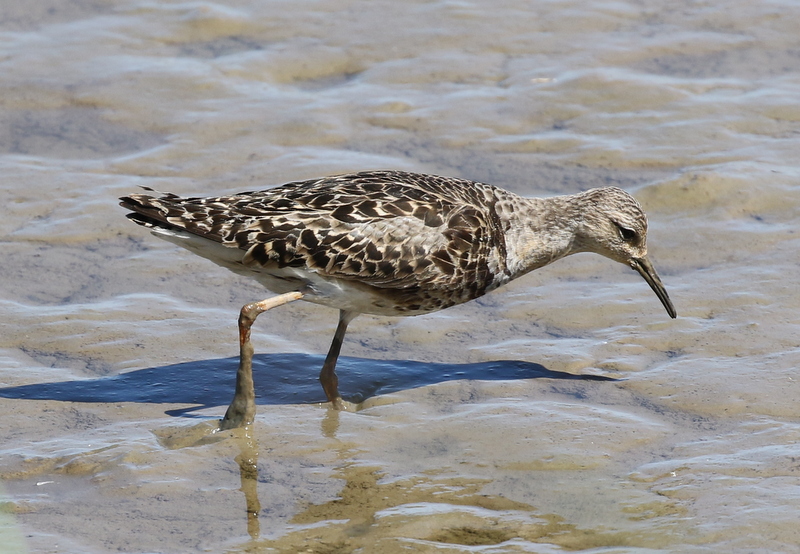 Ruff – the females (Reeves) are still moulting from summer plumage
Ruff – the females (Reeves) are still moulting from summer plumage
There were a few closer Black-tailed Godwits in front of Parrinder Hide when we arrived. We had two – one moulting out of its rusty orange summer plumage and the other already in grey winter plumage – close to us.
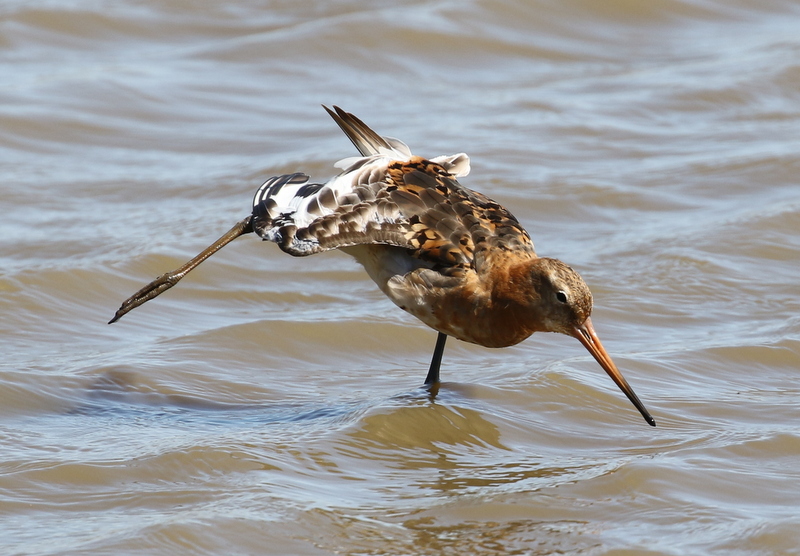 Black-tailed Godwit – moulting out of summer plumage
Black-tailed Godwit – moulting out of summer plumage
Then all the waders scattered and we looked across to see a Hobby hurtling in from the direction of the Volunteer Marsh. It made a low pass over the freshmarsh, putting everything up, then circled back round, making another dive down over the Volunteer Marsh, before flying back across in front of us again. Despite its best efforts, the Hobby didn’t come away with anything to show for it. It was a great display for us, though!
 Hobby – made a couple of low passes over the Freshmarsh
Hobby – made a couple of low passes over the Freshmarsh
There were lots of gulls and terns sheltering from the wind here today, roosting on the islands and in the shallow water. Along with good numbers of Common Terns, we found a larger, black-billed Sandwich Tern or two. Despite a claimed lack of interest in gulls, we managed to sneak quite a few in to the day’s viewing. A couple of Mediterranean Gulls included a bright red-billed adult, in winter plumage now sporting a black bandit mask, and a scallop-backed juvenile moulting into 1st winter. A much paler grey backed Yellow-legged Gull was in with the also yellow-legged Lesser Black-backed Gulls.
 Mediterranean Gull – a scaly juvenile moulting to 1st winter
Mediterranean Gull – a scaly juvenile moulting to 1st winter
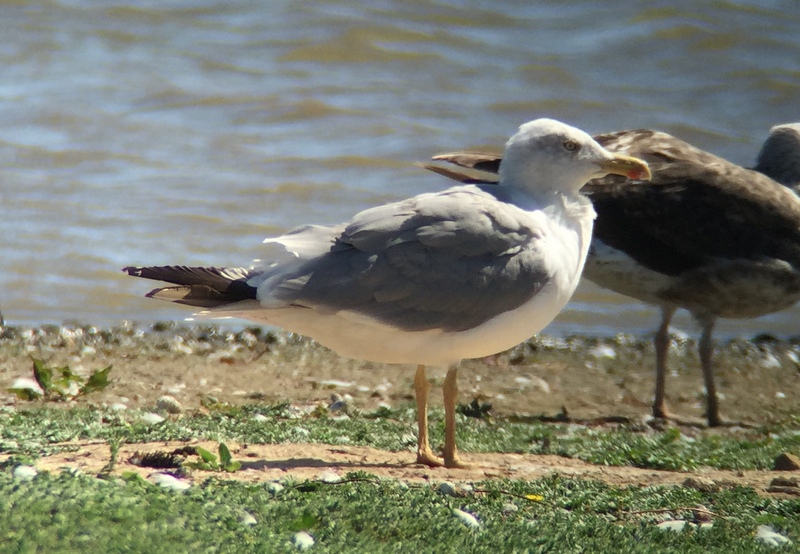 Yellow-legged Gull – an adult
Yellow-legged Gull – an adult
We had one more site we wanted to visit today, on our way back. So rather than exhaust ourselves too much at Titchwell with a walk out to the beach, we headed back to the car. We drove east along the coast to Stiffkey. The hedges along the path out to Stiffkey Fen are getting very overgrown now, so we had to push our way through at first, before the path opened out a bit. A Common Buzzard appeared briefly above the trees.
There were several Gatekeepers in the sunshine along the sheltered edge of the hedge. Several little skippers were fluttering around the thistles by the path and one stopped long enough to identify it as a Small Skipper. A smart male Banded Demoiselle was fluttering in the sunlight by the river, flashing irridescent blue-green. When we stopped for a closer look, we found a couple of bright green female Banded Demoiselles basking on the overhanging foliage too.
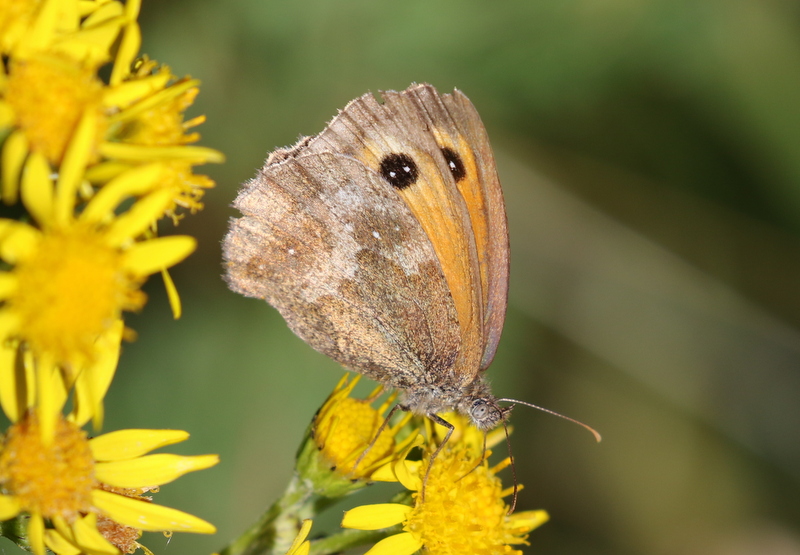 Gatekeeper – enjoying the sun in the shelter of the hedge
Gatekeeper – enjoying the sun in the shelter of the hedge
It is hard to see the Fen from the footpath at the moment, but much better from out in the open on the top of the seawall. From up here, we could see lots of birds out on the islands. We counted fourteen Spoonbills here and, even better, several of them were awake. A small group of four juveniles were feeding in the shallows, showing off their still rather smaller dark fleshy-coloured spoon-bills. Then a smart adult Spoonbill decided to have a bathe and, between splashes, we could see its longer black spoon-shaped bill with a distinctive yellow tip.
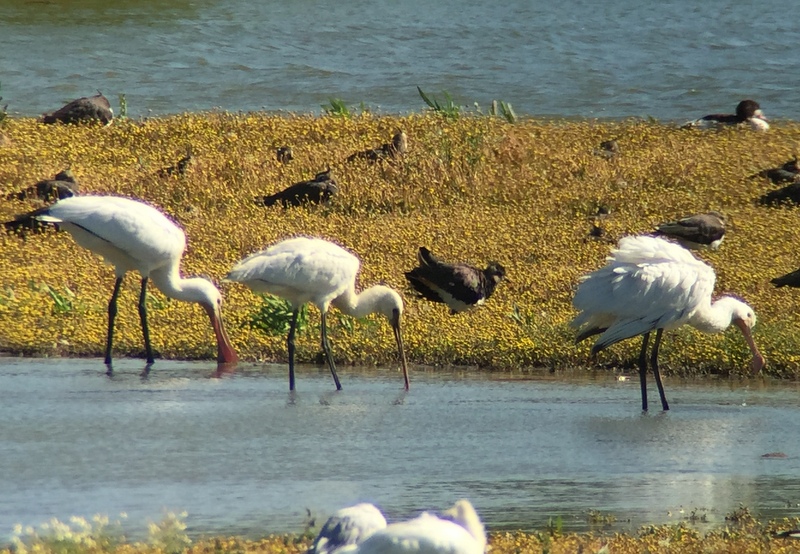 Spoonbill – three of the fourteen at Stiffkey Fen, these being juveniles
Spoonbill – three of the fourteen at Stiffkey Fen, these being juveniles
Amongst all the sleeping geese and ducks, we could see a good number of waders here too – Black-tailed Godwits, Redshank, a few Ruff, lots of Lapwing. Several Avocets were feeding in the deeper water. In with the mob of local Greylags were a couple of feral white farmyard geese and two Bar-headed Geese, presumably escaped from a local wildfowl collection – a motley assortment!
Out on the other side of the seawall, the tide was out. A single Whimbrel was preening on the edge of one of the muddy channels. Through the scope, we could see its striped head pattern. In the middle of the mud in the harbour, a mass of white shapes were Sandwich Terns – one flew overhead from the Fen carrying a fish and headed out towards them. We could see all the seals hauled out in the sun on a sandbank beyond.
It was lovely up here in the afternoon sunshine, but unfortunately we had to drag ourselves away – it was time to head for home. As we turned to go, a Kingfisher flashed across the reeds and disappeared into the river channel beyond – a lovely way to end.
















